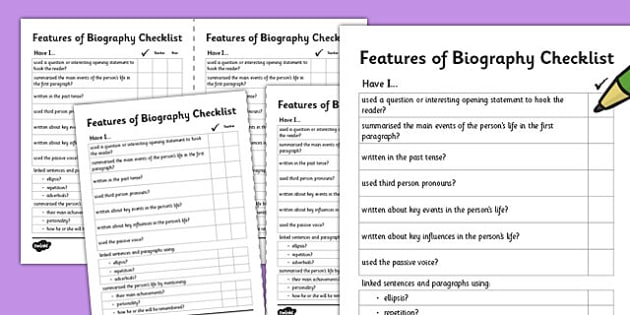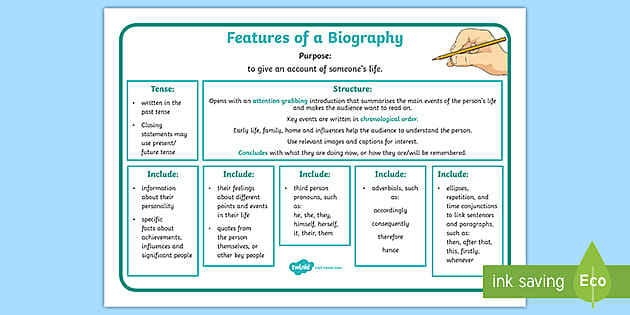A biography is an account of someone’s life written by another person. Biographies provide detailed accounts of an individual’s life, often including family background, education, work history, and relationships. While biographies can be written about anyone, they are usually limited to famous or influential figures. Biographies tend to emphasize certain aspects of someone’s life, such as their major accomplishments or the events that shaped them. They can also provide insight into the person’s character and the motivations behind their actions. There are several features that make a biography stand out from other types of writing.
Definition of a Biography
A biography is a written account of someone’s life. It can tell the story of an individual’s life from birth to death, or it can focus on a specific period or event. Biographies can range from formal to informal, and can be written in a variety of styles. Regardless of the style, a biography will generally include details about the person’s childhood, the people and events that shaped their life, and the successes and accomplishments they achieved. Through a biography, a reader can learn about the person’s experiences, values, and beliefs, as well as their major life milestones. A biography can be a powerful way to understand an individual’s life and legacy.
Types of Biography
Biographies can be written about any person, living or dead. But regardless of the subject, all biographies are composed of certain features that are essential to the genre. Biographies can be divided into three main types: traditional biographies, autobiographies, and biographical sketches.
Traditional biographies are written by an outside author who researches and writes about the life of a person. This type of biography typically focuses on major events in the person’s life. It may include personal details, such as family background, education, and career accomplishments, as well as the person’s impact on society.
Autobiographies are written by the person themselves. This type of biography focuses on the individual’s personal experiences and reflections. It is often more detailed than a traditional biography, since the author has access to their own memories and emotions.
Biographical sketches are documents that focus on a brief period of a person’s life. This type of biography is usually written by an outside author, but it is much shorter than a traditional biography. This type of biography is often used to capture a particular moment or event in a person’s life.
Whatever type of biography is written, it is important to ensure that the content is engaging, informative, and optimized for search engines. Writing a biography is an art, and when done correctly, it can provide readers with a unique insight into the life of the subject.
Common Elements of a Biography
A biography is a detailed written account of a person or group’s lives, often with the purpose of illuminating the subject’s accomplishments and contributions. Biographies can range from short, basic accounts of a person’s life to lengthy, complex works that capture the nuances of a person’s life and influence. Despite their difference in length and complexity, most biographies contain common elements and features that provide readers with a comprehensive view of the subject.
A good biography will give readers insight into a person’s life by covering important details from childhood to adulthood, including education, family and relationships, and major events and accomplishments. It will also explain the subject’s influence on culture, society, and history, and how they have impacted the world. Additionally, biographies are often written with the purpose of showcasing the subject’s unique perspective and experiences.
Biographies should also feature primary sources, such as firsthand accounts, interviews, and personal papers, to give the story an added layer of credibility. It should also include research from secondary sources, such as books, magazine articles, and newspaper clippings. The writing should be engaging and interesting, as it should capture the reader’s attention and keep them engaged with the story. Finally, the work should be well-researched and accurate, giving readers an honest and balanced view of the subject.
By incorporating these common elements, biographers can create compelling stories that give readers an in-depth look at the person or group’s life, accomplishments, and influence.

Benefits of Writing a Biography
Biographies can provide us with a unique insight into the lives of amazing people and inspire us to achieve greatness. Writing a biography is an excellent way to document a person’s life and share it with others. There are many benefits of writing a biography, such as gaining a better understanding of the individual, learning from their experiences and mistakes, and inspiring others.
By writing a biography of someone, you can gain a better understanding of their beliefs, motivations, and the events that shaped their lives. You can learn valuable lessons from their successes and failures, and gain insight into their achievements. It can also provide an opportunity to reflect on their legacy and how they impacted the world around them.
Writing a biography can also be an inspirational experience. By learning more about the subject of the biography, you can be inspired to pursue your own goals and dreams. This can help you understand the importance of making the most of every opportunity and pushing yourself to reach your full potential.
In addition, writing a biography can help you develop important writing skills. You can learn how to craft an engaging story, conduct research, and edit your work. These skills can be useful in other areas of your life, such as writing essays or creating resumes.
Overall, writing a biography can be a rewarding experience that offers numerous benefits. It can provide you with a better understanding of the subject, help you learn valuable lessons from their successes and failures, and inspire you to pursue your own dreams. It can also help you develop important writing skills that can be useful in other areas of your life.
Writing a Biography: Tips and Tricks
Writing a biography is no easy feat. It requires research, understanding, and a lot of creativity. But don’t be discouraged, there are some tips and tricks you can use to make the process easier.
First, research is key. Make sure you understand the person’s life, their accomplishments, and their experiences. To do this, you’ll want to look through their archives, articles, and any other sources you can find. This will help you develop a better understanding of who the person is and will help you craft a more detailed narrative.
Second, focus on the structure of the biography. Think about the structure you’ll use, how the story will flow, and which elements and facts to include. It’s important to create a narrative that is both engaging and informative. To do that, you’ll want to break the story up into sections, use quotes, and use vivid language.
Third, remember to stay true to the person’s life. Don’t exaggerate events or fabricate information. You want to stay as true to the facts as possible. It’s also important to consider the person’s perspective and how they would want their life to be portrayed.
Finally, it’s important to edit and revise your work. Make sure you check for typos, grammar mistakes, and any inconsistencies in the narrative. Also, consider having another set of eyes read it over for feedback.
Writing a biography is a daunting task, but with the right tips and tricks, you can create a compelling and engaging story. Research, structure, accuracy, and revisions are all key components to a successful biography.
Examples of Successful Biographies
Biographies are an essential part of our culture, whether it’s a book about a famous person or the personal story of a relative. A good biography has the potential to inspire and teach us about someone else’s life and struggles. But what makes a successful biography?
To answer this question, let’s look at some of the most popular biographies of all time. For example, Steve Jobs’ biography by Walter Isaacson was a tremendous success, as was Laura Hillenbrand’s Unbroken. Both of these biographies are written in a captivating style that draws readers into the story and evokes emotions.
Successful biographies are also incredibly detailed, often incorporating primary sources such as interviews and documents. Isaacson’s book, for example, includes over forty interviews with Jobs’ family, friends, and competitors. Unbroken is also filled with striking details, such as Hillenbrand’s description of a prisoner’s experience on a Japanese submarine during World War II.
At the same time, successful biographies are compelling and relatable. They don’t just tell the story of someone’s life; they also reveal universal truths and themes. Jobs’ biography, for example, is a story of ambition, passion, and innovation, while Unbroken is a tale of resilience and triumph over adversity.
By looking at successful biographies, we can see that the keys to a great biography are compelling storytelling, detailed research, and a universal message. With these elements, a biography can be a powerful and inspiring record of someone’s life.
FAQs About the Features Of A Biography
Q1: What are the main features of a biography?
A1: The main features of a biography include the telling of a person’s life story, highlighting their accomplishments, as well as the challenges and obstacles they have faced. It may also include details about the person’s personal life, their family, their education, and their career.
Q2: Does a biography need to include an introduction?
A2: It is not necessary to include an introduction in a biography, although it can be used to provide context or background information about the person.
Q3: What kind of writing style is used in a biography?
A3: Biographies are typically written in a narrative style, which allows the author to tell the story of the person’s life. The tone of the writing should be neutral and objective, while still conveying the emotions and struggles of the subject.
Conclusion
A biography is a detailed account of a person’s life. It is a comprehensive story about an individual’s experiences, achievements, and struggles. Biographies often provide insight into the life of the person being written about and can be both interesting and informative. They can provide readers with an understanding of how the individual overcame challenges and made their mark on history. Biographies can also be used to explore the motivations and actions of people in different time periods and cultures. The features of a biography can vary widely, but typically include a narrative of the individual’s life, their accomplishments, and their lasting impact.




